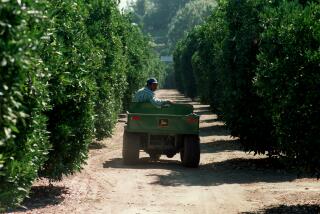Forlorn Salute to a Bygone Era : Sylmar: A state landmark recognizes the former film ranch of the legendary director D.W. Griffith. It is, however, mostly ignored.
Call it the lonely monument.
Along an industrial stretch of Foothill Boulevard in Sylmar--near a towing company, a vacant lot and a boarded-up house--stands a rock and bronze memorial to a largely forgotten era from the San Fernando Valley’s past, days of ranchers, movie moguls and, incredibly, reindeer.
Today, California Registered Historical Landmark No. 716 stands a few feet from the front door of Blanc Aircraft Fasteners, giving the impression that the state officials conferred historical status on a bolt manufacturer.
But when it was installed in 1959, at Foothill Boulevard and Vaughn Street, the monument in this now-unlikely venue saluted it as the former site of the Griffith Ranch, once owned by early movie director D.W. Griffith.
Regarded by many movie historians as the preeminent figure in American film history because of the story-telling camera techniques he pioneered, Griffith purchased the ranch, originally part of the San Fernando Mission land grant, in 1912. The director, not to be confused with Griffith J. Griffith of Griffith Park fame, filmed some productions at the ranch.
“It provided the locale for many Western thrillers, including ‘Custer’s Last Stand,’ and was the inspiration for the immortal production, ‘Birth of a Nation,’ ” the plaque reads. “The Birth of a Nation” was Griffith’s historic 1915 Civil War film.
The monument, dedicated in 1959, is mostly ignored. “I’ve never read it,” said one Blanc employee as he hurried past the marker Monday. “I’ve been here only a year.”
But Owen Smith, owner of a nearby painting service, walked across the street last week to read the plaque. Smith said he thought the monument might mention the conquest of California.
“When I saw that it was a movie lot. . . .” He broke off his sentence and laughed.
Diane Marten, a secretary at Blanc, said some history buffs occasionally visit the site. A few years ago an old man who said he had worked at the ranch came by to visit. “What happened to it?” he asked of the ranch.
“He looked a little disappointed,” Marten said. “It was sure something in his day.”
Indeed it was. The application requesting landmark status for the site described the ranch as 550 acres of mountains, riverbeds and orchards, said Marvin Brienes, historian with the state’s Office of Historic Preservation in Sacramento.
The ranch was purchased in 1948 by Fritz B. Burns, an admirer of Griffith, who lobbied for its landmark status. The application, submitted in October, 1959, said of the site: “Today much of the ranch remains the same as it was in the days of Mission control.”
But the letter also cited a major contrast with the days of Franciscan friars--a herd of 104 white reindeer chiefly used in Christmas celebrations. The application, with some understatement, described the reindeer as “an interesting sight,” Brienes said.
Faint graffiti mars the plaque, but the monument is in good shape. And lucky. A few years ago, Marten said, a runaway water truck, left unattended by its driver, flew past the monument and slammed into the building.
“It smashed the entire lobby, but it missed this,” Marten said.
(Even now, Marten prides herself on her snappy remark to the stunned truck driver as he walked into what remained of the lobby, viewing the havoc his truck caused: “Deliveries are in the back.”)
When told the story of the runaway truck, Brienes said it was no accident that the monument escaped harm. “That was providential preservation,” he quipped.
“We don’t allow our plaques to be hit by trucks.”
More to Read
Sign up for Essential California
The most important California stories and recommendations in your inbox every morning.
You may occasionally receive promotional content from the Los Angeles Times.










